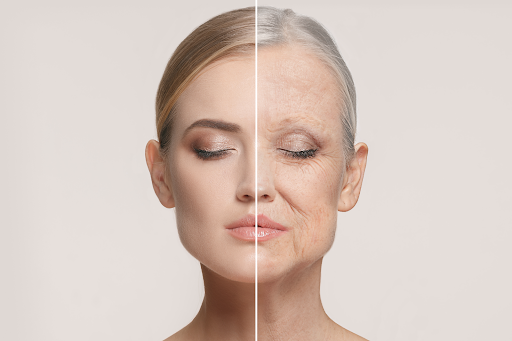Unveiling the Mystery Behind the Lines and Strategies to Embrace Radiant Skin

Wrinkles. Those etched lines on our faces can spark a rollercoaster of emotions – acceptance, concern, or even a desperate search for the fountain of youth. But wrinkles are a natural part of the aging process, and understanding their causes and treatment options empowers us to embrace healthy, radiant skin at every stage of life.
This comprehensive blog delves deep into the world of wrinkles, exploring their formation, different types, influencing factors, and a variety of treatment options. We’ll also explore natural and preventative strategies to promote youthful-looking skin and navigate the ever-evolving world of wrinkle reduction. So, whether you’re curious about the science behind wrinkles or seeking solutions to minimize their appearance, this blog is your one-stop guide.
The Science Behind Wrinkles: Unveiling the Culprits
Wrinkles form due to a complex interplay of factors, primarily the breakdown of collagen and elastin in the skin. Collagen, a protein, provides structure and support, while elastin, another protein, allows skin to snap back after stretching. As we age, collagen production naturally decreases, and elastin fibers lose their elasticity. This loss of support leads to the visible lines and folds on our skin – wrinkles.
Here’s a breakdown of the key players:
- Collagen: Imagine collagen as the scaffolding that holds your skin firm and plump. As collagen production declines, the scaffolding weakens, leading to sagging and wrinkles.
- Elastin: Think of elastin as the rubber band in your skin. It allows your skin to stretch and bounce back. With age, elastin fibers weaken, causing skin to lose its elasticity and form wrinkles.
- Hyaluronic acid: This molecule acts like a sponge, holding onto moisture in the skin. As hyaluronic acid levels decrease with age, skin becomes dehydrated, contributing to the appearance of wrinkles.
The Wrinkle Rogues' Gallery: Different Types and Their Causes
Wrinkles come in various shapes and sizes, each with its own story to tell. Here are some common types and the factors influencing their formation:
- Fine lines: These delicate lines are often the first signs of aging and typically appear around the eyes and mouth. Sun exposure, dehydration, and smoking can accelerate their formation.
- Deep wrinkles: These more pronounced lines are caused by significant collagen and elastin loss. They often form on the forehead, between the brows (frown lines), and around the mouth (smile lines).
- Crow’s feet: These radiating lines around the eyes are often caused by repeated facial expressions like squinting or smiling.
- Marionette lines: These vertical lines run from the corners of the mouth down towards the chin. They can be caused by collagen loss, sun damage, and genetics.
- Neck wrinkles: The delicate neck area is prone to wrinkles due to sun exposure, repetitive neck movements, and sleep position.
Beyond the natural aging process, several external factors can exacerbate wrinkle formation:
- Sun exposure: Ultraviolet (UV) rays from the sun are one of the most significant contributors to wrinkles. UV rays damage collagen and elastin fibers, accelerating the aging process of the skin.
- Smoking: Smoking restricts blood flow to the skin, depriving it of essential nutrients and oxygen. It also breaks down collagen and elastin, leading to premature wrinkling.
- Dehydration: Dry skin lacks the elasticity and plumpness needed to maintain a smooth appearance. Dehydration can worsen the appearance of wrinkles.
- Facial expressions: Repeated facial expressions like squinting, frowning, and smiling can lead to the formation of wrinkles over time.
- Genetics: Our genes play a role in how quickly our skin ages and how susceptible we are to wrinkles.
Unveiling the Wrinkle-Reduction Arsenal: Treatments and Procedures

While wrinkles are a natural part of life, there are various options available to minimize their appearance and promote a more youthful look. Here’s a glimpse into the world of wrinkle reduction treatments:
Non-Surgical Options:
- Topical retinoids: These creams and serums derived from vitamin A stimulate collagen production and promote cell turnover, reducing the appearance of fine lines and wrinkles.
- Botox injections: Botox relaxes the muscles that cause wrinkles, particularly frown lines and crow’s feet. The effects are temporary, typically lasting 3-4 months.
- Dermal fillers: Fillers like hyaluronic acid are injected beneath the skin to plump up wrinkles and restore lost volume. Different fillers address various types of wrinkles and have varying durations of effect.
- Chemical peels: These treatments remove the outer layer of dead skin cells, revealing smoother, younger-looking skin. The strength of the peel determines the depth of treatment and resulting downtime.
- Microneedling: This minimally invasive procedure involves creating tiny, controlled punctures in the skin with fine needles. This triggers the body’s natural healing response, encouraging collagen production and promoting skin tightening and rejuvenation.
Summary
In closing, wrinkles may be an inevitable part of aging, but proactive measures can significantly mitigate their appearance. Understanding their causes, such as collagen and elastin breakdown, sun exposure, smoking, dehydration, and genetics, is key to prevention. Adopting a skincare routine that includes sun protection, moisturizing, a healthy diet, staying hydrated, and avoiding smoking can help maintain skin elasticity and delay wrinkle formation. Additionally, regular exercise, adequate sleep, and stress management contribute to overall skin health. By embracing these preventative strategies, individuals can embrace aging gracefully and enjoy radiant, youthful-looking skin for longer.
